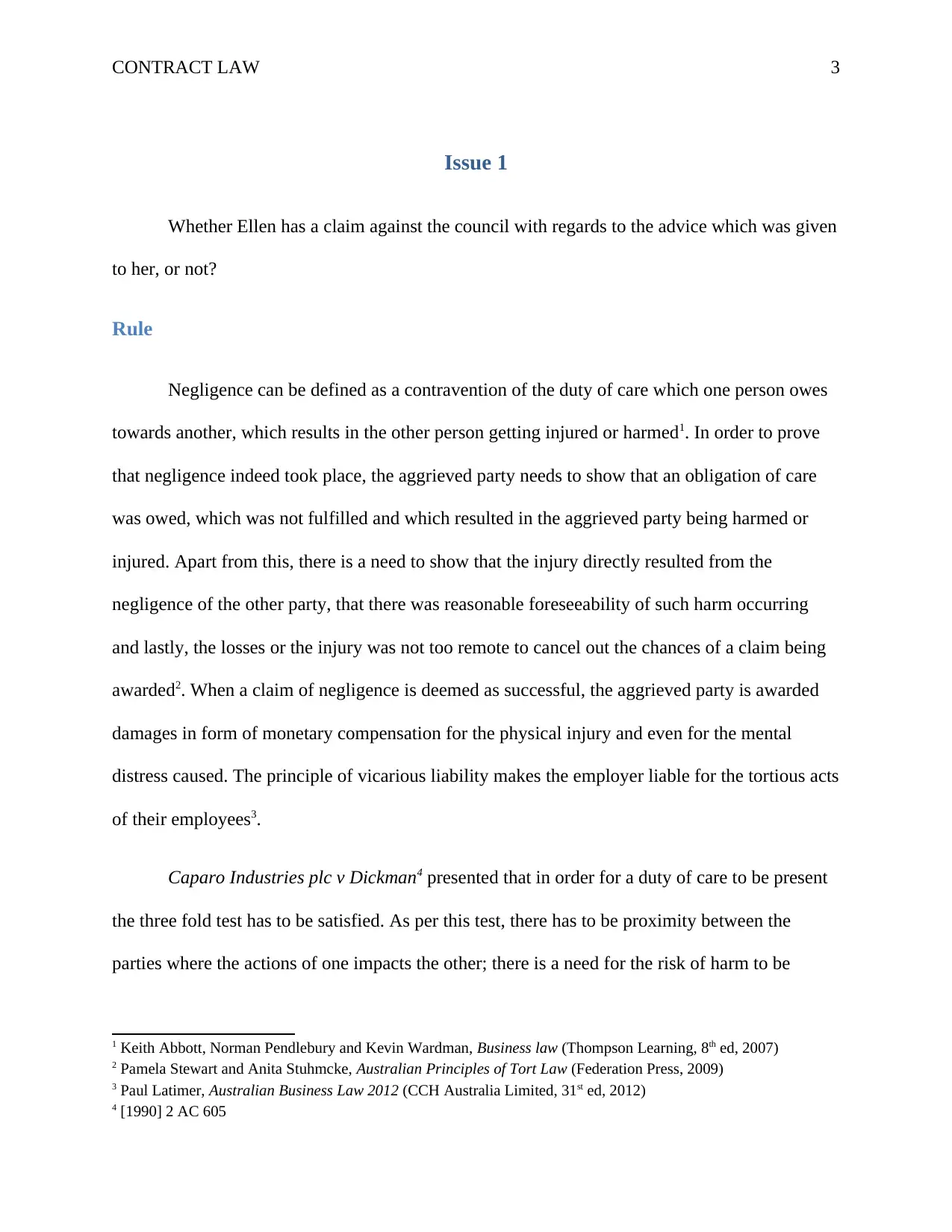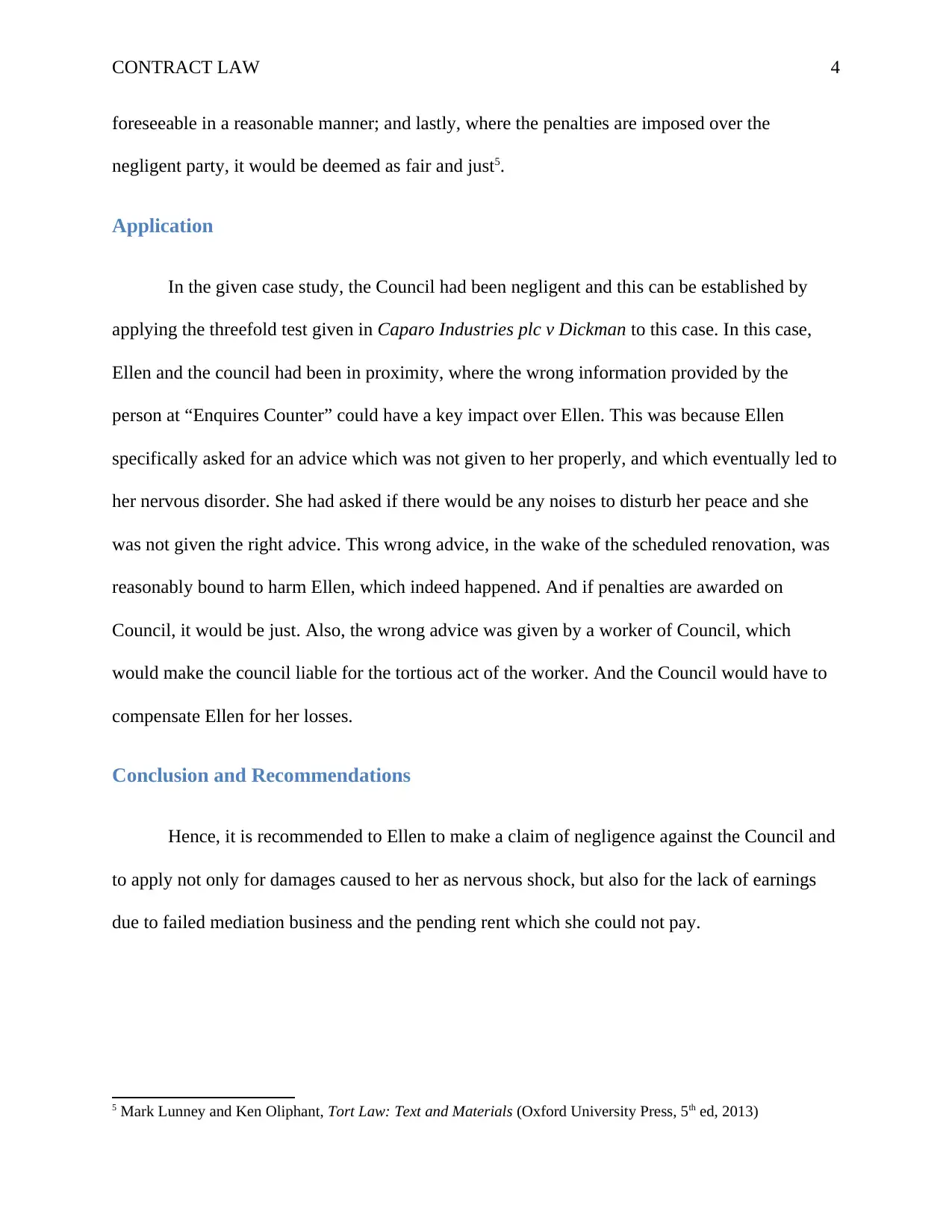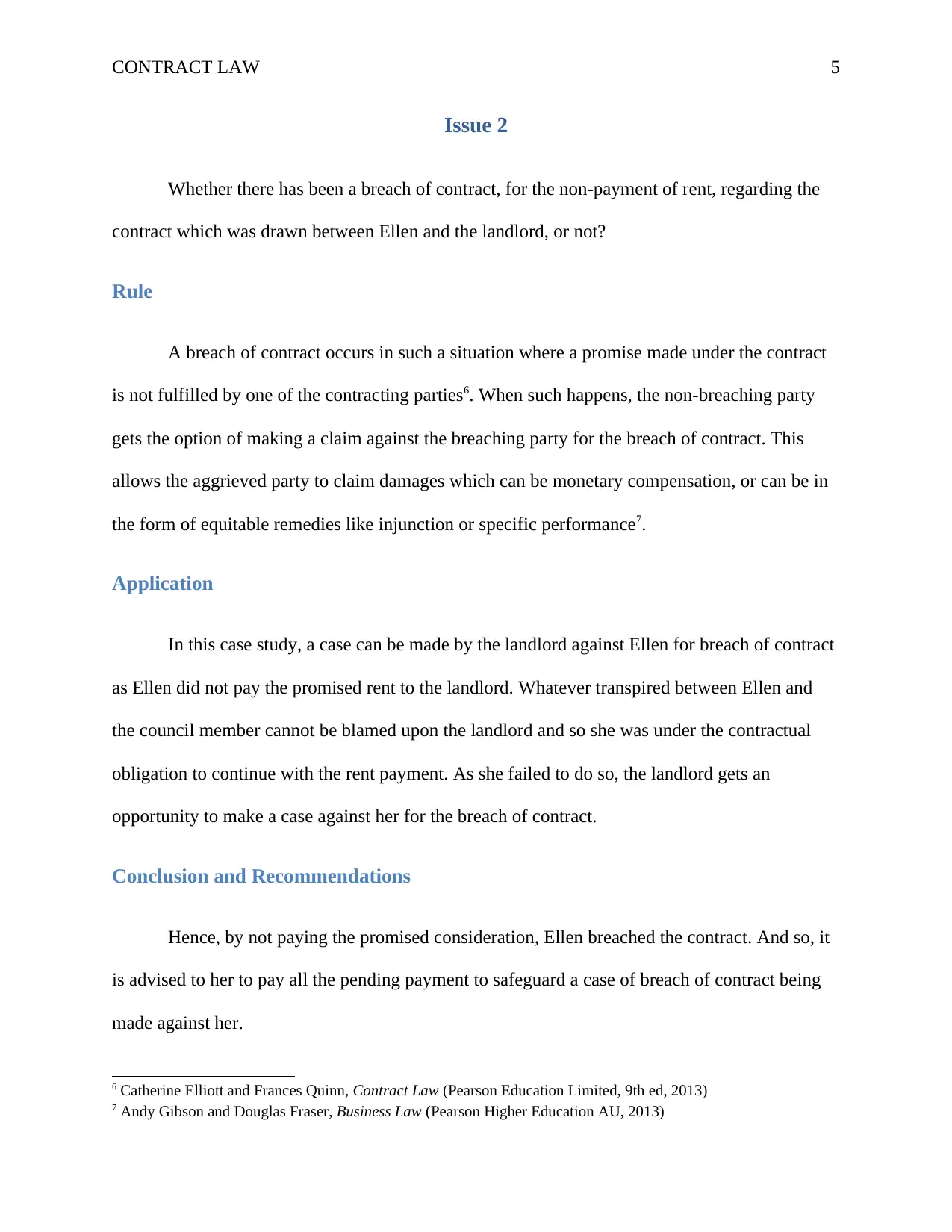LAW100 - Contract Law and Business Law Case Study Assessment
VerifiedAdded on 2020/03/16
|8
|1325
|30
Case Study
AI Summary
This case study analyzes a legal scenario involving Ellen and the Council. The case explores three primary issues: whether Ellen has a claim against the council for negligent advice, whether there was a breach of contract between Ellen and her landlord due to non-payment of rent, and whether a negligent misstatement was made by the Council worker. The analysis applies legal principles of negligence, breach of contract, and negligent misstatement, referencing relevant case law such as Caparo Industries plc v Dickman. The study concludes with recommendations for Ellen, advising her to pursue claims against the Council and manage her contractual obligations. The document also includes a bibliography of relevant legal texts and cases.

Paraphrase This Document
Need a fresh take? Get an instant paraphrase of this document with our AI Paraphraser

CONTRACT LAW 2
Table of Contents
Issue 1..............................................................................................................................................3
Rule..............................................................................................................................................3
Application..................................................................................................................................4
Conclusion and Recommendations..............................................................................................4
Issue 2..............................................................................................................................................5
Rule..............................................................................................................................................5
Application..................................................................................................................................5
Conclusion and Recommendations..............................................................................................5
Issue 3..............................................................................................................................................6
Rule..............................................................................................................................................6
Application..................................................................................................................................6
Conclusion and Recommendations..............................................................................................7
Bibliography....................................................................................................................................8
Articles/ Books/ Journals.............................................................................................................8
Cases............................................................................................................................................8
Legislations..................................................................................................................................8
Table of Contents
Issue 1..............................................................................................................................................3
Rule..............................................................................................................................................3
Application..................................................................................................................................4
Conclusion and Recommendations..............................................................................................4
Issue 2..............................................................................................................................................5
Rule..............................................................................................................................................5
Application..................................................................................................................................5
Conclusion and Recommendations..............................................................................................5
Issue 3..............................................................................................................................................6
Rule..............................................................................................................................................6
Application..................................................................................................................................6
Conclusion and Recommendations..............................................................................................7
Bibliography....................................................................................................................................8
Articles/ Books/ Journals.............................................................................................................8
Cases............................................................................................................................................8
Legislations..................................................................................................................................8

CONTRACT LAW 3
Issue 1
Whether Ellen has a claim against the council with regards to the advice which was given
to her, or not?
Rule
Negligence can be defined as a contravention of the duty of care which one person owes
towards another, which results in the other person getting injured or harmed1. In order to prove
that negligence indeed took place, the aggrieved party needs to show that an obligation of care
was owed, which was not fulfilled and which resulted in the aggrieved party being harmed or
injured. Apart from this, there is a need to show that the injury directly resulted from the
negligence of the other party, that there was reasonable foreseeability of such harm occurring
and lastly, the losses or the injury was not too remote to cancel out the chances of a claim being
awarded2. When a claim of negligence is deemed as successful, the aggrieved party is awarded
damages in form of monetary compensation for the physical injury and even for the mental
distress caused. The principle of vicarious liability makes the employer liable for the tortious acts
of their employees3.
Caparo Industries plc v Dickman4 presented that in order for a duty of care to be present
the three fold test has to be satisfied. As per this test, there has to be proximity between the
parties where the actions of one impacts the other; there is a need for the risk of harm to be
1 Keith Abbott, Norman Pendlebury and Kevin Wardman, Business law (Thompson Learning, 8th ed, 2007)
2 Pamela Stewart and Anita Stuhmcke, Australian Principles of Tort Law (Federation Press, 2009)
3 Paul Latimer, Australian Business Law 2012 (CCH Australia Limited, 31st ed, 2012)
4 [1990] 2 AC 605
Issue 1
Whether Ellen has a claim against the council with regards to the advice which was given
to her, or not?
Rule
Negligence can be defined as a contravention of the duty of care which one person owes
towards another, which results in the other person getting injured or harmed1. In order to prove
that negligence indeed took place, the aggrieved party needs to show that an obligation of care
was owed, which was not fulfilled and which resulted in the aggrieved party being harmed or
injured. Apart from this, there is a need to show that the injury directly resulted from the
negligence of the other party, that there was reasonable foreseeability of such harm occurring
and lastly, the losses or the injury was not too remote to cancel out the chances of a claim being
awarded2. When a claim of negligence is deemed as successful, the aggrieved party is awarded
damages in form of monetary compensation for the physical injury and even for the mental
distress caused. The principle of vicarious liability makes the employer liable for the tortious acts
of their employees3.
Caparo Industries plc v Dickman4 presented that in order for a duty of care to be present
the three fold test has to be satisfied. As per this test, there has to be proximity between the
parties where the actions of one impacts the other; there is a need for the risk of harm to be
1 Keith Abbott, Norman Pendlebury and Kevin Wardman, Business law (Thompson Learning, 8th ed, 2007)
2 Pamela Stewart and Anita Stuhmcke, Australian Principles of Tort Law (Federation Press, 2009)
3 Paul Latimer, Australian Business Law 2012 (CCH Australia Limited, 31st ed, 2012)
4 [1990] 2 AC 605
⊘ This is a preview!⊘
Do you want full access?
Subscribe today to unlock all pages.

Trusted by 1+ million students worldwide

CONTRACT LAW 4
foreseeable in a reasonable manner; and lastly, where the penalties are imposed over the
negligent party, it would be deemed as fair and just5.
Application
In the given case study, the Council had been negligent and this can be established by
applying the threefold test given in Caparo Industries plc v Dickman to this case. In this case,
Ellen and the council had been in proximity, where the wrong information provided by the
person at “Enquires Counter” could have a key impact over Ellen. This was because Ellen
specifically asked for an advice which was not given to her properly, and which eventually led to
her nervous disorder. She had asked if there would be any noises to disturb her peace and she
was not given the right advice. This wrong advice, in the wake of the scheduled renovation, was
reasonably bound to harm Ellen, which indeed happened. And if penalties are awarded on
Council, it would be just. Also, the wrong advice was given by a worker of Council, which
would make the council liable for the tortious act of the worker. And the Council would have to
compensate Ellen for her losses.
Conclusion and Recommendations
Hence, it is recommended to Ellen to make a claim of negligence against the Council and
to apply not only for damages caused to her as nervous shock, but also for the lack of earnings
due to failed mediation business and the pending rent which she could not pay.
5 Mark Lunney and Ken Oliphant, Tort Law: Text and Materials (Oxford University Press, 5th ed, 2013)
foreseeable in a reasonable manner; and lastly, where the penalties are imposed over the
negligent party, it would be deemed as fair and just5.
Application
In the given case study, the Council had been negligent and this can be established by
applying the threefold test given in Caparo Industries plc v Dickman to this case. In this case,
Ellen and the council had been in proximity, where the wrong information provided by the
person at “Enquires Counter” could have a key impact over Ellen. This was because Ellen
specifically asked for an advice which was not given to her properly, and which eventually led to
her nervous disorder. She had asked if there would be any noises to disturb her peace and she
was not given the right advice. This wrong advice, in the wake of the scheduled renovation, was
reasonably bound to harm Ellen, which indeed happened. And if penalties are awarded on
Council, it would be just. Also, the wrong advice was given by a worker of Council, which
would make the council liable for the tortious act of the worker. And the Council would have to
compensate Ellen for her losses.
Conclusion and Recommendations
Hence, it is recommended to Ellen to make a claim of negligence against the Council and
to apply not only for damages caused to her as nervous shock, but also for the lack of earnings
due to failed mediation business and the pending rent which she could not pay.
5 Mark Lunney and Ken Oliphant, Tort Law: Text and Materials (Oxford University Press, 5th ed, 2013)
Paraphrase This Document
Need a fresh take? Get an instant paraphrase of this document with our AI Paraphraser

CONTRACT LAW 5
Issue 2
Whether there has been a breach of contract, for the non-payment of rent, regarding the
contract which was drawn between Ellen and the landlord, or not?
Rule
A breach of contract occurs in such a situation where a promise made under the contract
is not fulfilled by one of the contracting parties6. When such happens, the non-breaching party
gets the option of making a claim against the breaching party for the breach of contract. This
allows the aggrieved party to claim damages which can be monetary compensation, or can be in
the form of equitable remedies like injunction or specific performance7.
Application
In this case study, a case can be made by the landlord against Ellen for breach of contract
as Ellen did not pay the promised rent to the landlord. Whatever transpired between Ellen and
the council member cannot be blamed upon the landlord and so she was under the contractual
obligation to continue with the rent payment. As she failed to do so, the landlord gets an
opportunity to make a case against her for the breach of contract.
Conclusion and Recommendations
Hence, by not paying the promised consideration, Ellen breached the contract. And so, it
is advised to her to pay all the pending payment to safeguard a case of breach of contract being
made against her.
6 Catherine Elliott and Frances Quinn, Contract Law (Pearson Education Limited, 9th ed, 2013)
7 Andy Gibson and Douglas Fraser, Business Law (Pearson Higher Education AU, 2013)
Issue 2
Whether there has been a breach of contract, for the non-payment of rent, regarding the
contract which was drawn between Ellen and the landlord, or not?
Rule
A breach of contract occurs in such a situation where a promise made under the contract
is not fulfilled by one of the contracting parties6. When such happens, the non-breaching party
gets the option of making a claim against the breaching party for the breach of contract. This
allows the aggrieved party to claim damages which can be monetary compensation, or can be in
the form of equitable remedies like injunction or specific performance7.
Application
In this case study, a case can be made by the landlord against Ellen for breach of contract
as Ellen did not pay the promised rent to the landlord. Whatever transpired between Ellen and
the council member cannot be blamed upon the landlord and so she was under the contractual
obligation to continue with the rent payment. As she failed to do so, the landlord gets an
opportunity to make a case against her for the breach of contract.
Conclusion and Recommendations
Hence, by not paying the promised consideration, Ellen breached the contract. And so, it
is advised to her to pay all the pending payment to safeguard a case of breach of contract being
made against her.
6 Catherine Elliott and Frances Quinn, Contract Law (Pearson Education Limited, 9th ed, 2013)
7 Andy Gibson and Douglas Fraser, Business Law (Pearson Higher Education AU, 2013)

CONTRACT LAW 6
Issue 3
Whether a negligent misstatement was made by the Council Worker, or not?
Rule
Negligent misstatement refers to a false statement or an inaccurate stamen being made by
one person to another, which is honestly but in a careless manner8. This is usually made in form
of an advice by one party who has special knowledge to the other party, which does not hold the
same knowledge or skill. There is a need to show, in order to present a case of negligent
misstatement that there was an element of fault, an actual damage and that obtaining remedy is
necessary to compensate the victim, instead of opting for punishing the wrong party9.
Application
In the given case study, when Ellen enquired about the possibility of the calm
environment being disturbed, she was told in a careless and negligent manner by the council
officer that she needed to relax and that everything would be fine. However, this statement was
made without paying heed to the question, in a careless, but honest manner. To show that a case
of negligent misstatement is present here, the fault element has to be established. In this case, it
can be clearly shown that it was the fault of the Council Officer that he did not give Ellen the
requisite information, when she asked him, particularly when he was at the enquiries counter.
Secondly, an actual damage was caused to Ellen as she sustained nervous shock from the stress
caused due to the development noise. And lastly, it was necessary to compensate Ellen for her
condition in this case.
8 Jenny Steele, Tort Law: Text, Cases, and Materials (Oxford University Press, 3rd ed, 2014)
9 Chris Turner, Unlocking Torts (Routledge, 3rd ed, 2013)
Issue 3
Whether a negligent misstatement was made by the Council Worker, or not?
Rule
Negligent misstatement refers to a false statement or an inaccurate stamen being made by
one person to another, which is honestly but in a careless manner8. This is usually made in form
of an advice by one party who has special knowledge to the other party, which does not hold the
same knowledge or skill. There is a need to show, in order to present a case of negligent
misstatement that there was an element of fault, an actual damage and that obtaining remedy is
necessary to compensate the victim, instead of opting for punishing the wrong party9.
Application
In the given case study, when Ellen enquired about the possibility of the calm
environment being disturbed, she was told in a careless and negligent manner by the council
officer that she needed to relax and that everything would be fine. However, this statement was
made without paying heed to the question, in a careless, but honest manner. To show that a case
of negligent misstatement is present here, the fault element has to be established. In this case, it
can be clearly shown that it was the fault of the Council Officer that he did not give Ellen the
requisite information, when she asked him, particularly when he was at the enquiries counter.
Secondly, an actual damage was caused to Ellen as she sustained nervous shock from the stress
caused due to the development noise. And lastly, it was necessary to compensate Ellen for her
condition in this case.
8 Jenny Steele, Tort Law: Text, Cases, and Materials (Oxford University Press, 3rd ed, 2014)
9 Chris Turner, Unlocking Torts (Routledge, 3rd ed, 2013)
⊘ This is a preview!⊘
Do you want full access?
Subscribe today to unlock all pages.

Trusted by 1+ million students worldwide

CONTRACT LAW 7
Conclusion and Recommendations
Hence, a negligent misstatement was made by the Council Worker for which, Ellen can
claim compensation.
Conclusion and Recommendations
Hence, a negligent misstatement was made by the Council Worker for which, Ellen can
claim compensation.
Paraphrase This Document
Need a fresh take? Get an instant paraphrase of this document with our AI Paraphraser

CONTRACT LAW 8
Bibliography
Articles/ Books/ Journals
Abbott K, Pendlebury N, and Wardman K, Business law (Thompson Learning, 8th ed, 2007)
Andy Gibson and Douglas Fraser, Business Law (Pearson Higher Education AU, 2013)
Elliott, C, and Quinn, F, Contract Law (Pearson Education Limited, 9th ed, 2013)
Latimer P, Australian Business Law 2012 (CCH Australia Limited, 31st ed, 2012)
Lunney M, and Oliphant K, Tort Law: Text and Materials (Oxford University Press, 5th ed,
2013)
Steele J, Tort Law: Text, Cases, and Materials (Oxford University Press, 3rd ed, 2014)
Stewart P, and Stuhmcke A, Australian Principles of Tort Law (Federation Press, 2009)
Turner C, Unlocking Torts (Routledge, 3rd ed, 2013)
Cases
Caparo Industries plc v Dickman [1990] 2 AC 605
Legislations
Contract Law
Tort Law
Bibliography
Articles/ Books/ Journals
Abbott K, Pendlebury N, and Wardman K, Business law (Thompson Learning, 8th ed, 2007)
Andy Gibson and Douglas Fraser, Business Law (Pearson Higher Education AU, 2013)
Elliott, C, and Quinn, F, Contract Law (Pearson Education Limited, 9th ed, 2013)
Latimer P, Australian Business Law 2012 (CCH Australia Limited, 31st ed, 2012)
Lunney M, and Oliphant K, Tort Law: Text and Materials (Oxford University Press, 5th ed,
2013)
Steele J, Tort Law: Text, Cases, and Materials (Oxford University Press, 3rd ed, 2014)
Stewart P, and Stuhmcke A, Australian Principles of Tort Law (Federation Press, 2009)
Turner C, Unlocking Torts (Routledge, 3rd ed, 2013)
Cases
Caparo Industries plc v Dickman [1990] 2 AC 605
Legislations
Contract Law
Tort Law
1 out of 8
Related Documents
Your All-in-One AI-Powered Toolkit for Academic Success.
+13062052269
info@desklib.com
Available 24*7 on WhatsApp / Email
![[object Object]](/_next/static/media/star-bottom.7253800d.svg)
Unlock your academic potential
Copyright © 2020–2025 A2Z Services. All Rights Reserved. Developed and managed by ZUCOL.




